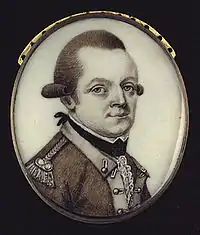Daniel Claus
Christian Daniel Claus (1727–1787) was a Commissioner of Indian Affairs and a prominent Loyalist during the American Revolution.

He was born September 13, 1727 at Bönnigheim, Württemberg the son of Adam Frederic Claus and his wife Anna Dorothea. He arrived in America in 1749. In 1755 he was made a Lieutenant in the Indian Department and a Deputy Secretary of Indian Affairs.
He had lived with Joseph Brant and the Mohawks for a while and could speak their language.
In September 1775, he was replaced as the deputy superintendent by Major John Campbell. In November, Daniel Claus sailed to London to appeal his case before the British House of Lords. He was given the post of deputy confined to working with the Iroquois refugees in Canada. In August, 1777, he was appointed as agent of the Six Nations Indians by Frederick Haldimand.
He died November 9, 1787 near Cardiff, Wales.
Family
Claus married Ann "Nancy" Weisenberg (Johnson) Claus.[1] Their son William Claus (1765-1826) was a government official, militia officer, military figure in the War of 1812 and at one point was Deputy Superintendent of the Indian Department.[2] Daniel's father-in-law was Sir William Johnson, who was the British government's superintendent of northern Aboriginal people, and whose son Sir John Johnson became Superintendent General of Indian Affairs.[2][3]
References
- https://www.myheritage.com/research/record-10110-172494/daniel-claus-in-canadian-headstones?utm_source=partner_wikitree&utm_medium=partner&utm_campaign=wikitree_apr20&tr_funnel=data
- "William Claus | The Canadian Encyclopedia". www.thecanadianencyclopedia.ca. Retrieved Oct 16, 2020.
- http://www.uelac.org/Book-Reviews/PDF/Johnson-genealogical-chart.pdf
- Leighton, Douglas (1979). "Claus, Christian Daniel". In Halpenny, Francess G (ed.). Dictionary of Canadian Biography. IV (1771–1800) (online ed.). University of Toronto Press.
- Parsons, Phyllis Vibbard (October 1962). "The Early Life of Daniel Claus". Pennsylvania History: A Journal of Mid-Atlantic Studies. 29 (4): 357–372. JSTOR 27770134.